Blog
November 10th, 2010
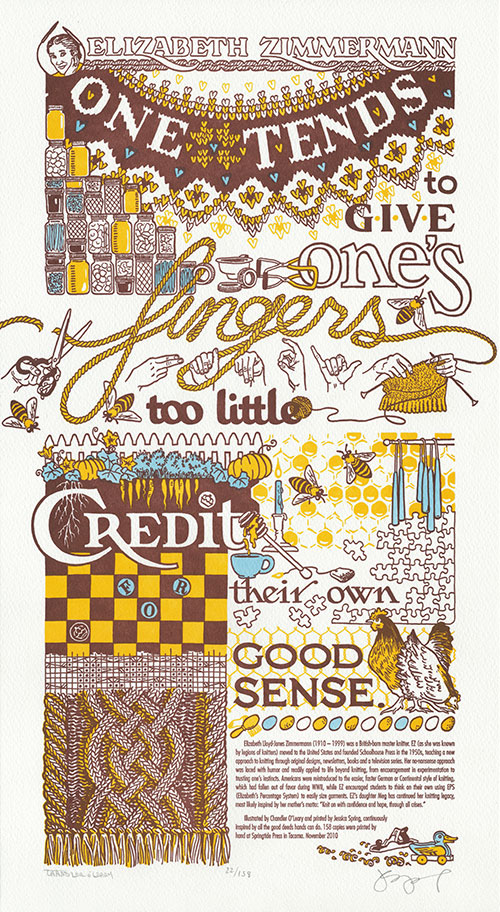
Maybe it’s the changing seasons. Or the fact that the farmers market runneth over with delicious autumn goodies. Or maybe we just wanted to talk about something that made us smile, for a change—because this time, for our tenth Dead Feminist broadside, Jessica and I have turned to a subject somewhat lighter of heart.
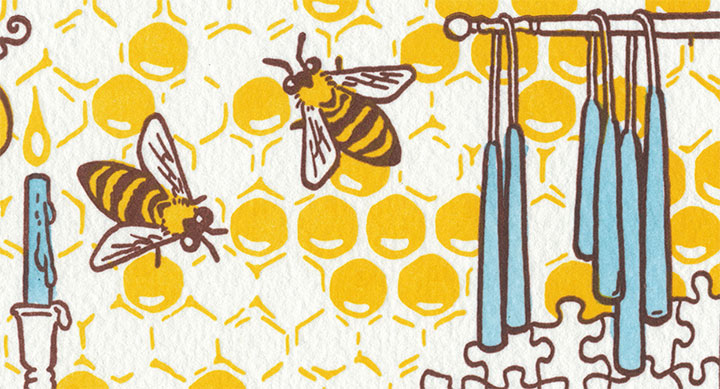
From the likes of urban homesteaders, artisans, D.I.Y.-ers, and hobbyists of all stripes, brilliant handiwork is all around us. We are in constant admiration of the power of one’s own two hands, and the good deeds they can do. And for the perfect symbol of a handmade life infused with joy and meaning, we’ve handed the microphone to Elizabeth Zimmermann:
One tends to give one’s fingers too little credit for their own good sense.

Now, as many of you probably know, Ms. Zimmermann was a knitter (that’s an understatement; I’d say more like All-Time Super-Queen Knitter of the Cosmos, Forever and Ever, Amen). But like every knitter, there is so, so much more to her than that. So rather than simply leaving it at yarn and wool, we discovered a cornucopia of the pursuits that fingers like to turn to when they’re not knitting. There are no idle hands here, to be sure.

Just in time for the fall harvest and in cozy preparation for the winter months ahead (or for our friends in the southern hemisphere, looking forward to a fruitful summer), Get Handy overflows with simple pleasures and home comforts. Elizabeth drafts a cable pattern and whips up a Fair Isle yoke. A little slow food takes root in the garden. Honeybees guard a new crop of candles. Fresh home-canned treats stock the shelves. Chickens scratch along a fence of golden (darning) eggs. Over a cup of tea, puzzles piece together and checkers crown kings. And when they’ve put down the yarn and scissors, the hands spell it out for you in American Sign Language.
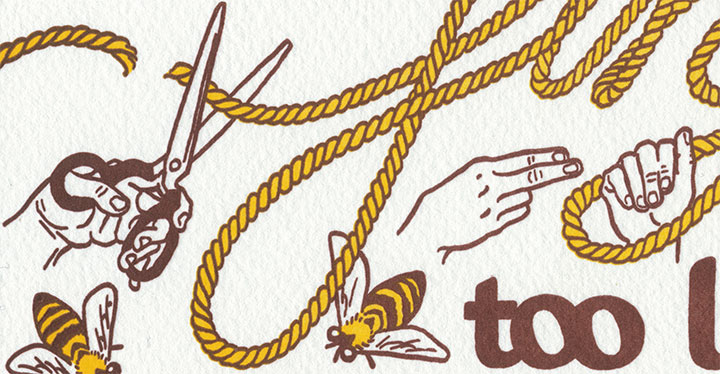
Oh, and the Tailor’s blueberries and Jessica’s dilly beans make a cameo appearance. Yum.

A portion of the proceeds from Get Handy will be donated to the amazing healing hands of Médecins Sans Frontières / Doctors Without Borders, via Tricoteuses Sans Frontières / Knitters Without Borders, which organizes knitters to raise funds for MSF/DWB. MSF, winner of the 1999 Nobel Peace Prize, is a medical relief organization dedicated to assisting people in distress around the world.
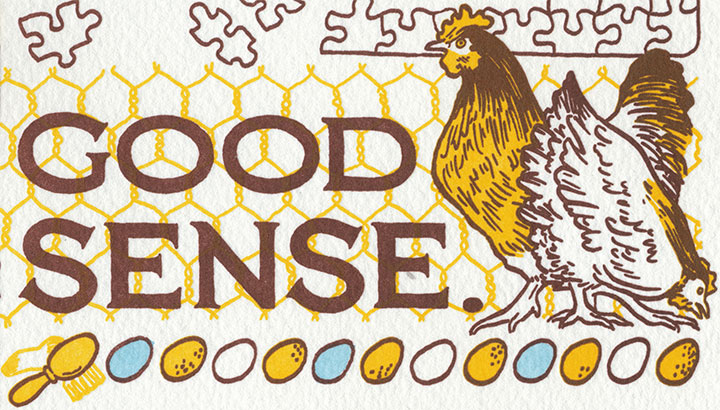
• • • • • • • • • • • • • • • • • • • • • • • • • • • • • • • • • • • • • • • • • • • • • • • • • • • • • • • • • • • •
Get Handy: No. 10 in the Dead Feminists series
Edition size: 158
Poster size: 10 x 18 inches
Printed on an antique Vandercook Universal One press, on archival, 100% rag paper. Each piece is hand-colored and signed by both artists.
Colophon reads:
Elizabeth Lloyd-Jones Zimmermann (1910 – 1999) was a British-born master knitter. EZ (as she was known by legions of knitters) moved to the United States and founded Schoolhouse Press in the 1950s, teaching a new approach to knitting through original designs, newsletters, books and a television series. Her no-nonsense approach was laced with humor and readily applied to life beyond knitting, from encouragement in experimentation to trusting one’s own instincts. Americans were reintroduced to the easier, faster German or Continental style of knitting, which had fallen out of favor during WWII, while EZ encouraged students to think on their own using EPS (Elizabeth’s Percentage System) to easily size garments. EZ’s daughter Meg had continued her knitting legacy, most likely inspired by her mother’s motto: “Knit on with confidence and hope, through all crises.”
UPDATE: poster is sold out. Reproduction postcards available in the Dead Feminists shop!

October 11th, 2010
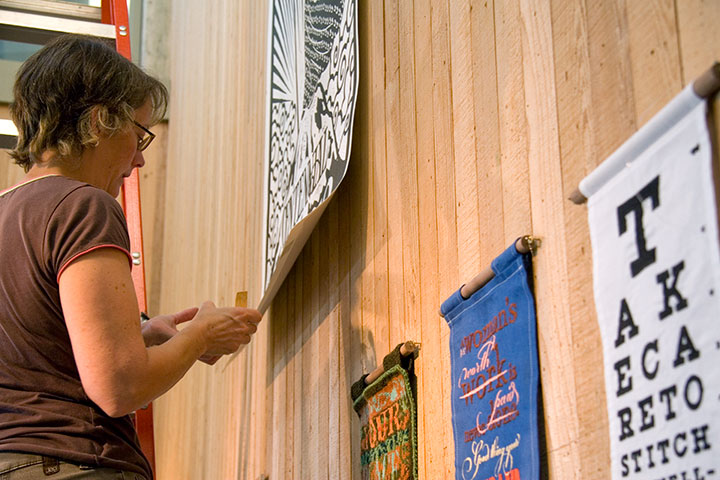
While I’ve been hiding away, wrangling my 900-pound gorilla, Jessica has been cooking up something pretty great.
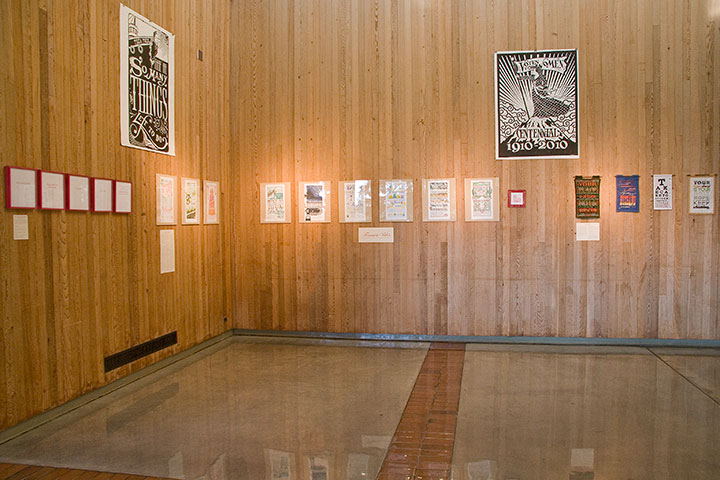
Thanks to her hard work and the wonderful Brian Hutcheson‘s invitation, we are pleased as punch to announce our first-ever dual exhibition!
Feminist Wiles: Jessica Spring and Chandler O’Leary
Now through November 5
Ted Sanford Gallery, Charles Wright Academy
7723 Chambers Creek Rd. W
Tacoma, Washington
Open 8 to 5, Monday through Friday
It seems weird that after more than two years of collaborating, giving lectures and printing in the street, we’ve never had an honest-to-goodness show together.
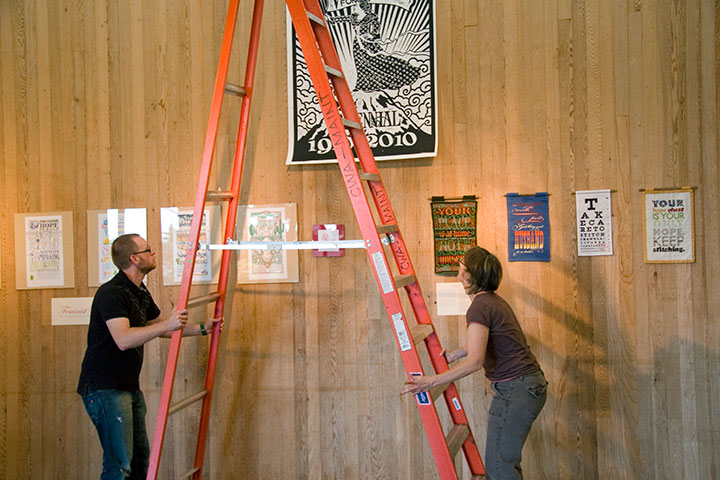
But when Brian offered us a cavernous space, his help with installation, and the chance to indoctrinate the innocent introduce our series to the kids at Charles Wright—well, we’d be nuts to pass that up.
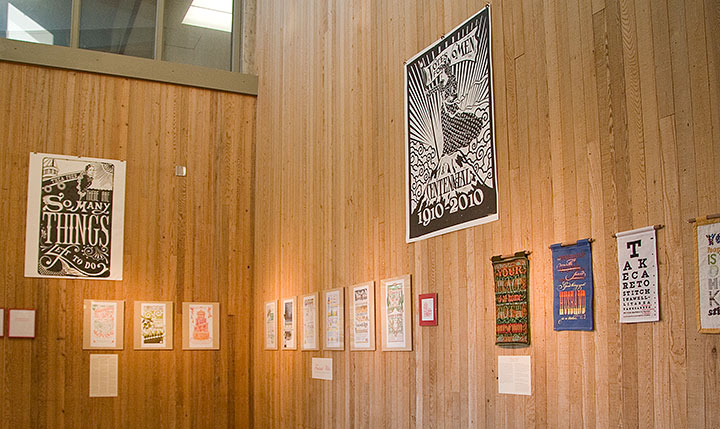
For the first time, all nine (and-a-half) Dead Feminist broadsides to date, plus our two steamroller gals, are on display together.
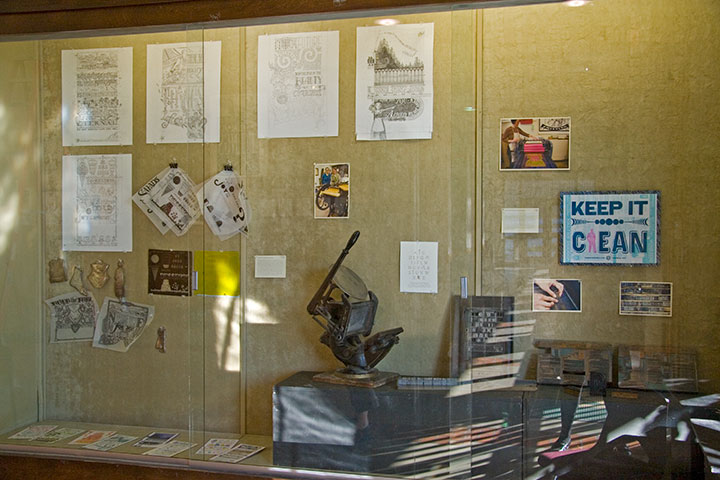
We also have a little mini-exhibit about our process,

and lots of little goodies to introduce people to letterpress.
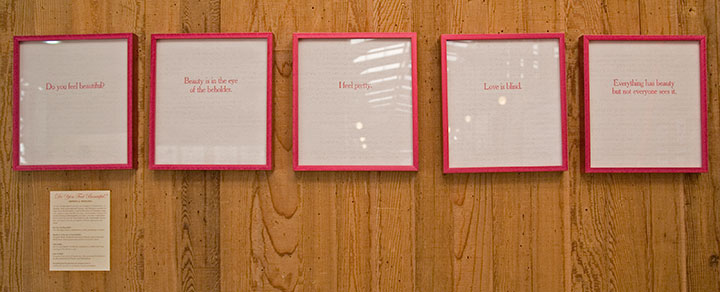
Jessica and I have rounded out the collection with solo work that complements the theme of the show. Jessica’s half consists of Do You Feel Beautiful?, a series of broadsides featuring famous aphorisms on beauty. Here’s the thing that blows my mind into tiny pieces every time I think of it: the quotes are letterpress printed on the pages of a Braille edition of Seventeen magazine. Whoa.
I contributed Women’s Work, an ongoing series of broadsides created in hand-sewn textiles rather than my usual letterpress.
Now, I get a ton of questions about these things whenever I show them, so I thought I’d outline the ideas and process behind them here.
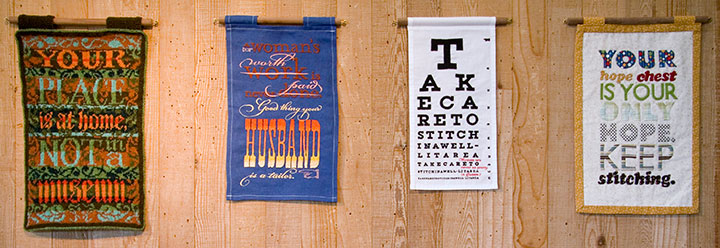
The Tailor first sparked the idea for the series; as you know, he makes his own clothing (hence the nickname). This is a feat that never ceases to amaze me, and I’m not the only one—he gets a lot of comments, usually along the lines of “Wow, you made that?” He’s always a little surprised by these comments, because where he grew up, a lot of people (including his family) wore homemade clothing. That got me thinking, though. The people who do all that sewing in the Tailor’s hometown are women—mothers, grandmothers, sisters, daughters, wives. We’re all surrounded and preceded by generations of women who sew clothing, or knit sweaters, or draft patterns from scratch, without any rave reviews—or any comment at all. But every male knitter or quilter I’ve known, every rare and wonderful man who ever picked up a needle, is either looked at like he’s nuts, or treated with reverent awe. It strikes me as a little strange that depending on who made it, and who’s looking at it, a pair of pants can be a work of art—and an actual work of art can be completely ignored.
If you go further back, like, I dunno, throughout the entirety of human history—you’ll find that both men and women have been responsible for creating textile goods in nearly every culture on earth. Yet in almost every case, when men made textiles it was as part of some sort of guild craft or other professional setting. When women made textiles, it was as part of the home front. This is true in every part of the globe, in pretty much every era, going back to the advent of textile technology.
No matter who does the stitching, there’s an enormous amount of technical skill and design sensibility required to make a garment or textile object. So instead of creating divisions and pigeonholes—instead of separating into Art and Not Art, into Man-made and Woman-made, what if we started seeing the inherent worth in the objects themselves? And what happens when we take a handmade textile and stick it in a gallery? Does its perception change?
Based on what I’ve seen so far with these broadsides, I’d say it does. It’s been an interesting experiment, for sure.
So the Women’s Work series is a bit of an indictment of the double standard, and while the snark is aimed at a wider target, I wrote them as if I were speaking to a woman. Each one is completely made/knitted/sewn/pieced/embroidered/etc. by hand, from design to pattern to construction. The text reads in the voice of a disapproving female role model (or the insidious voice inside our own heads)—in the tone of the backhanded compliment, the cheerful put-down. Each is also designed in the style of a traditional letterpress broadside, to put the typography within the context of an art form centered around mass communication.

This guy requires a little more of an explanation for folks who aren’t already into wool.

This piece, made almost three years ago now, is hand-knitted with Shetland wool, using the traditional Fair Isle knitting technique. Fair Isle—a method practiced since the nineteenth century on the tiny island of the same name, halfway between Scotland and Norway—is a tricky, rather ingenious thing. Traditional Fair Isle pieces are knit with two colors of yarn at the same time; the resulting fabric is durable, extremely warm, and great for any chilly, foggy, wet climate (like, hello, here). Beyond its über-practicality, Fair Isle knitting is simply gorgeous (take a gander at Google). By nature the double-thick fabric is dense and flat, making it an ideal ground for complex patterns and designs—it’s the perfect mix of function and fancy.
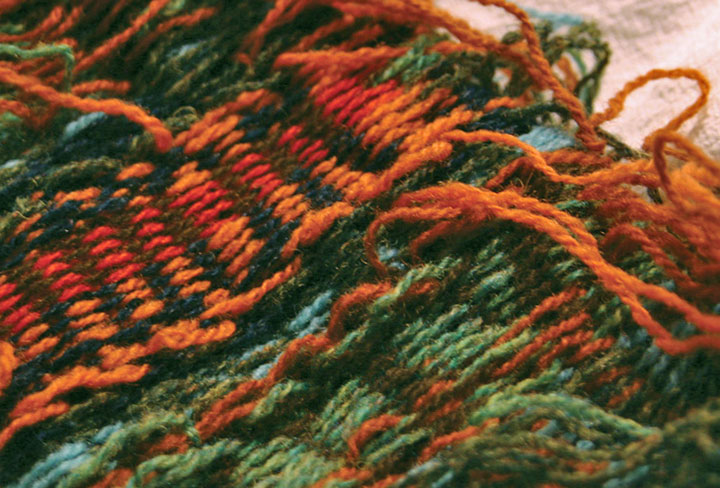
Here’s how it works: even though the piece is knitted with two different colors of yarn at once, only one strand at a time ever passes through the needles. The unused strand of yarn is carried loosely, or “floated,” behind the work—which creates a reversed-out image of the design on the back of the piece. It’s the floats that give structure to the fabric, and make it so cozy-warm.
If you were to create a plain ol’ piece of ordinary knitting, you’d proceed from one end to the other of a row, flip the piece over, and work back the other direction. Rinse and repeat. If you tried that with a piece of Fair Isle knitting, working the “wrong” side would be extremely difficult, since the floats would now be facing you and covering your stitches. Now comes the tricky, smarty-pants part. Flat Fair Isle pieces are first knitted up into a big round tube, and then cut to lie flat. When you knit in the round, you never encounter the wrong side of the work. You just spiral around and around on the right side, happily knitting away and floating the unused color behind you as you go.
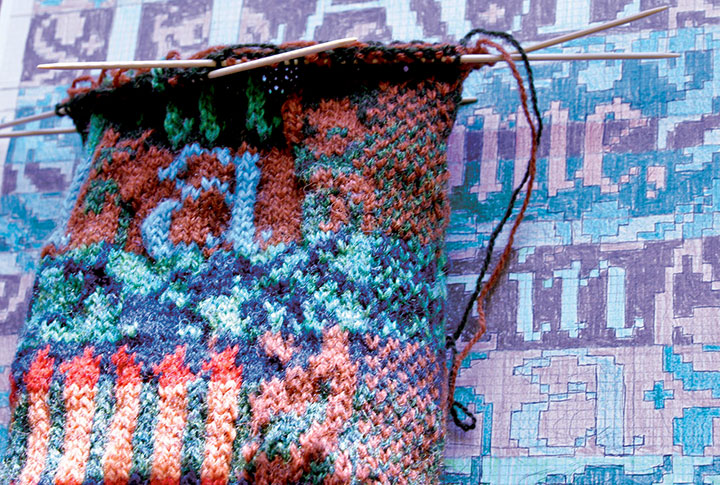
So in this case, once I had drafted my design into a gridded stitch pattern, I just pretended I was knitting one really big sleeve (or a neck warmer for a giraffe) with really teeny needles.
Ah, but remember the operative words above: you have to cut the piece to finish it. I had never done this before, and let me tell you, there’s an awful, terrifying finality to the idea. Torn sweaters unravel. Snagged socks fall apart. Who in their right mind would cut a piece of knitting on purpose? And even if you could do it, what happens if you make a mistake? Once you make that cut, you’re done.
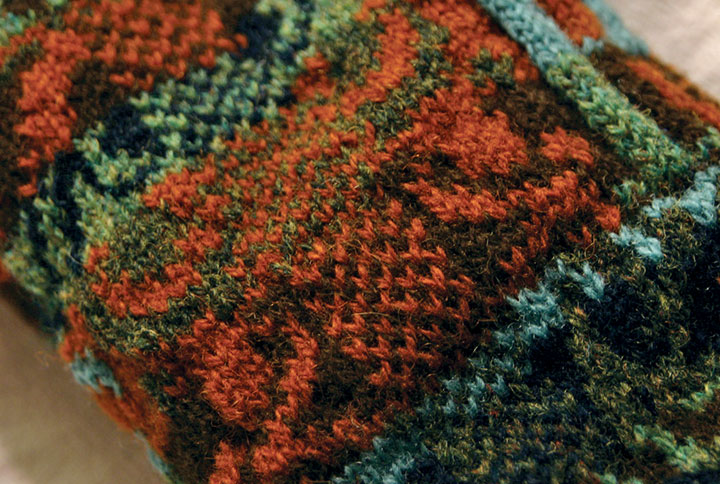
This is where the true brilliance of the technique hit me like a ton of bricks. The Scotswomen of Fair Isle are a breed apart—and so are their sheep. Shetland wool, the material traditionally used in Fair Isle knitting, has a magical property that makes this crazy notion work: each wool fiber is covered with microscopic scales that attach to one another. Because the wool sticks to itself, the stitches become slightly matted as you knit. So following the Fair Isle method, you work a little buffer zone called a steek (see the checkerboard strip above?) into your design, and then cut right down the center of the steek. If you use trusty Shetland wool, your stitches won’t unravel when you cut them.
At least, that was the theory. I didn’t quite believe it at the time. But I’d come this far—I didn’t want to lose faith. (If you’re looking to try Fair Isle knitting yourself, I find a glass of wine helps.) So I took a steadying swig, held my breath, and cut.
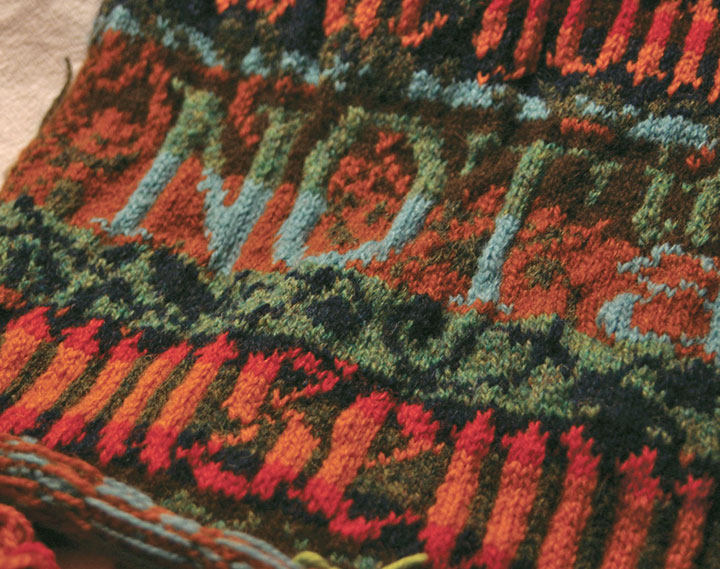
And then I exhaled. And blinked. I had a flat piece. Gingerly I tested the cut edge—and was amazed. Even with a fair bit of tugging, the stitches refused to unravel.
I will never question a Scotswoman again.
My favorite thing about all of this, beyond the magic of Fair Isle itself, is that knitting really lends itself well to letterforms. Even though the pattern is drafted out on a grid, the forgiving nature of knitted stitches turns every square on the grid into a slightly curved, irregular shape. So when you zoom out and look at the piece from a distance, those grid “pixels” turn into nice little serifs, curves and curlicues.
The rest of the broadsides in the series are made using other types of needlework (more on that in the next post), but the knitted piece is still my favorite. I think I need another dose of that Fair Isle magic in my life—maybe next year you’ll find me up to my knees in wool again.
(Read about the rest of the “Women’s Work” broadsides in part two.)

September 3rd, 2010
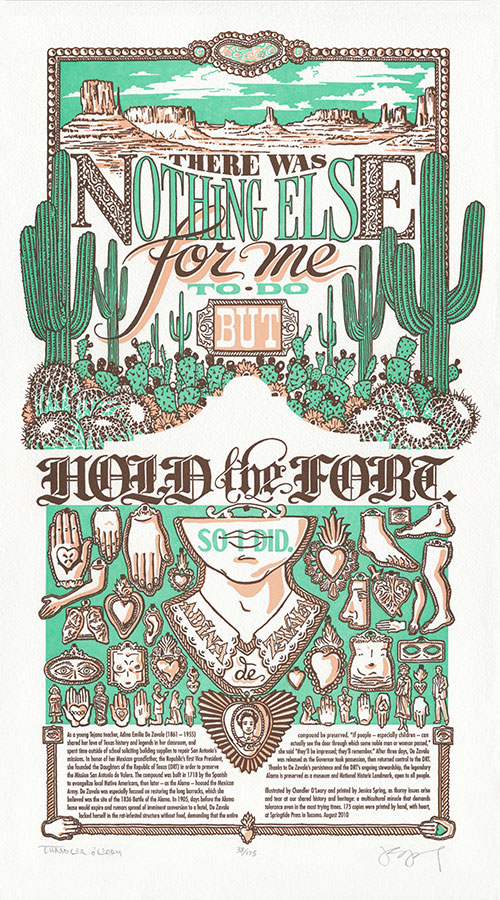
As autumn approaches and the inevitable rainy season knocks at our doors, Jessica and I are dreaming of the sunny skies of Arizona—where the not-so-sunny SB 1070, the state’s contentious new immigration reform bill, was signed into law earlier this year. At every turn, controversy pricks underfoot and looms overhead—with no easy, clear-cut answers in sight. So for our newest Dead Feminist broadside, we decided to challenge the controversy face-to-face-to-hand-to-heart with the words of Tejana activist Adina De Zavala:
There was nothing else for me to do but hold the fort. So I did.
In complete contrast with our last broadside, we had a short n’ sweet quote to work with this time—which gave me every reason and all kinds of room to go completely nuts with the imagery. I think my subconscious had a hand in steering us toward Adina and her quote, because I suddenly had the chance to explore a whole slew of filed-away themes and images that I had never been able to work into a piece before. My brain was swimming with ideas, and I found myself cackling out loud at the prospect of finally getting the chance to put so many of my favorite things into one crazy illustration. Green skies! Monument Valley! Mexican blackletter! Milagros! Cactus-spine fractal geometry! Mwa ha ha!
Ahem. I should probably back up the train a bit and give you the whole nerdy spiel.

On a Mission teems with icons of both the American Southwest and Mexican folk culture. A desert landscape—framed with metallic scrollwork and crazy-lace agate cabochons— stretches to the horizon, while saguaro sentinels tower over a tangled mess of prickly pears and barrel cacti. That was the easy part—thorny issue? Check.
The hard part was putting in all of our nebulous and conflicted feelings about the Alamo (represented here as an absence of imagery; a silhouette of negative space) and the topic at hand. So for answers I looked to Mexican folk art—so prominent on both sides of the Border, and so beautifully expressive, layered in history and meaning.
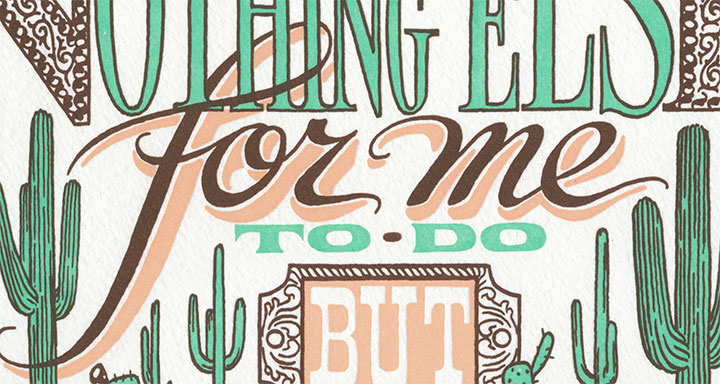
The text itself helped us get right to the point about that. The typography is influenced both by the American Old West and modern-day Mexico—particularly the latter. Mexico’s strong tradition of hand-lettering survives today, particularly in the form of hand-painted signs and advertisements. Inspiration ranged from the fluid folksiness of drop-shadowed cursive script—

—to the proud refinement of blackletter, a hold-out of the early Spanish colonial printers that has evolved to attain near-sacred importance in Mexican and Mexican-American popular culture. As we were conscious of our desire to “reclaim” some of the connotations behind the Alamo, blackletter provided the perfect weight and cultural twist to the phrase “Hold the fort.”
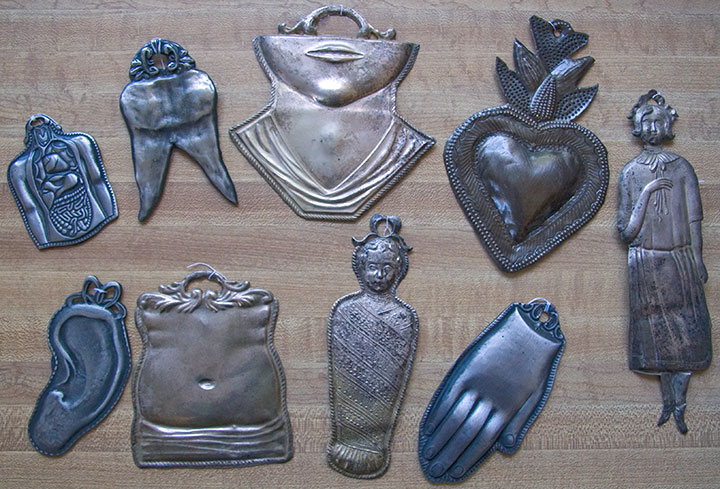
And then there’s my favorite part of the whole project: strewn all over the lower half of the illustration is a collection of milagros. Literally translated to “miracles,” milagros are small, stamped-metal votives that are typically hung in the shrines and churches of many Catholic countries—offered up in thanks for prayers answered and blessings received.
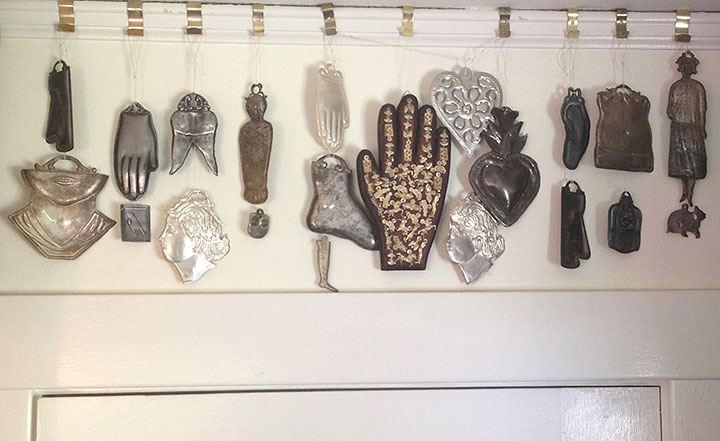
On my lifetime list of All-around Best Things Ever, milagros are very near the top—as evidenced by the growing collection in my studio. When I lived in Rome (where they are called ex votos), I used to pick them up on Sunday-mornings at the Porta Portese flea market for next to nothing. Ever since then, they’ve popped up in my work every now and then.
Well, now they get to be the stars of the show. If the Alamo were still the mission I picture in my head, the walls would be covered, floor to ceiling, with milagros. And since Adina herself has become a bit of a legend for her place in the Alamo’s history, illustrated devotionals adorn her name and portrait like pinned hopes.
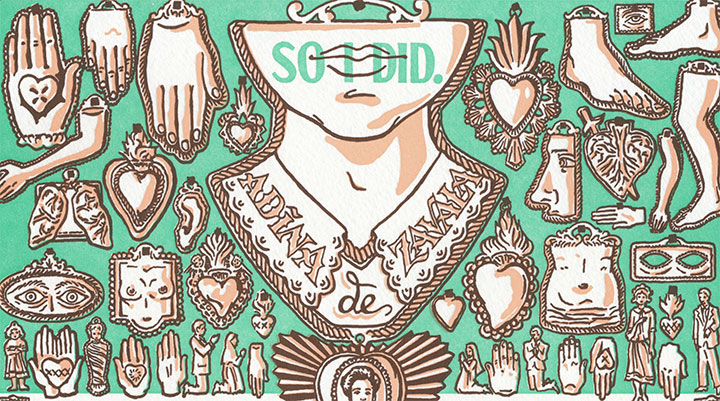
It may seem strange to get so giddily excited about illustrating such a serious topic, but somewhere along the way I realized that it’s that excitement over the positive that has given me perspective on the issue at hand. That what we think of as the “American” Southwest is so iconic and so dear to us because of the peoples with whom we share it. That the Southwest wouldn’t be what it is without its link to hundreds of years of both native and newcomer culture—just as America wouldn’t be America without immigration and cultural diversity. That keeping our multicultural vibrance alive is what makes us whole.
So in that spirit, a portion of the proceeds from On a Mission will be donated to the Northwest Immigrant Rights Project, a non-profit organization dedicated to promoting justice and legal rights for immigrants and refugees from more than 100 countries around the world.
I don’t know if any of this stuff crossed Adina De Zavala’s mind while she camped out inside the Alamo. She was just an individual who fought to keep an old, rotting building standing—and the place was a controversial symbol, even then (it certainly still is today). But she knew that the controversy was part of the legend of the place, and part of our heritage. And she knew the value of preserving that heritage for everyone’s benefit, without exception—so she held the fort. I think she deserves a few milagros on our wall for that.
• • • • • • • • • • • • • • • • • • • • • • • • • • • • • • • • • • • • • • • • • • • • • • • • • • • • • • • • • • • •
On a Mission: No. 9 in the Dead Feminists series
Edition size: 175
Poster size: 10 x 18 inches
Printed on an antique Vandercook Universal One press, on archival, 100% rag paper. Each piece is signed by both artists.
Colophon reads:
As a young Tejana teacher, Adina Emilia De Zavala (1861 – 1955) shared her love of Texas history and legends in her classroom, and spent time outside of school soliciting building supplies to repair San Antonio’s missions. In honor of her Mexican grandfather, the Republic’s first Vice President, she founded the Daughters of the Republic of Texas (DRT) in order to preserve the Mission San Antonio de Valero. The compound was built in 1718 by the Spanish to evangelize local Native Americans, then later—as the Alamo—housed the Mexican Army. De Zavala was especially focused on restoring the long barracks, which she believed was the site of the 1836 Battle of the Alamo. In 1905, days before the Alamo lease would expire and rumors spread of imminent conversion to a hotel, De Zavala locked herself in the rat-infested structure without food, demanding that the entire compound be preserved. “If people—especially children—can actually see the door through which some noble man or woman passed,” she said, “they’ll be impressed; they’ll remember.” After three days, De Zavala was released as the Governor took possession, then returned control to the DRT. Thanks to De Zavala’s persistence and the DRT’s ongoing stewardship, the legendary Alamo is preserved as a museum and National Historic Landmark, open to all people.
Illustrated by Chandler O’Leary and printed by Jessica Spring, as thorny issues arise and tear at our shared history and heritage: a multicultural miracle that demands tolerance even in the most trying times. 175 copies were printed by hand, with heart, at Springtide Press in Tacoma. August 2010
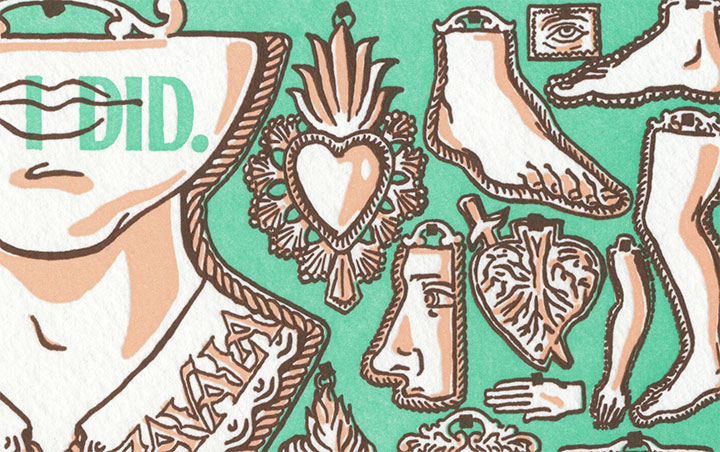
UPDATE: poster is sold out. Reproduction postcards available in the Dead Feminists shop!
August 31st, 2010
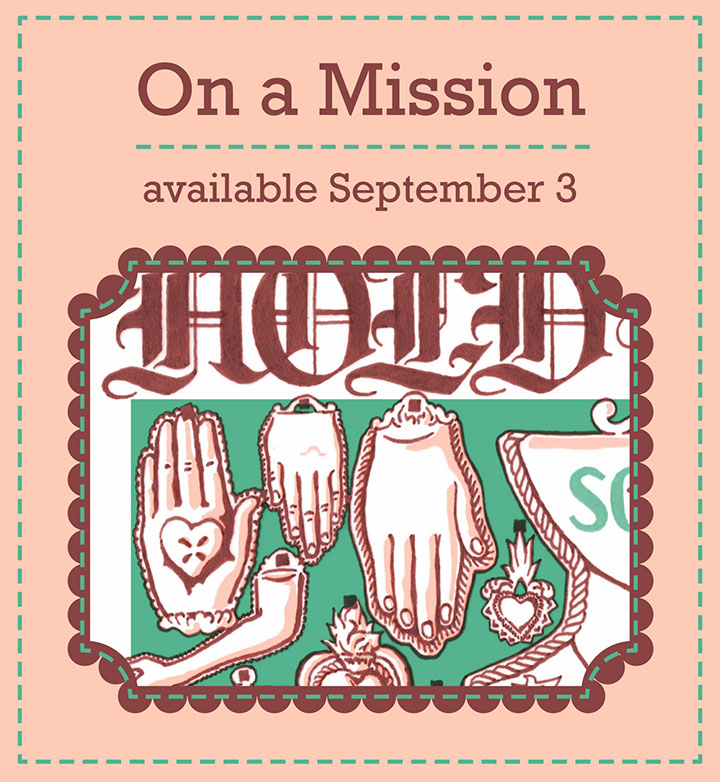
At the Wayzgoose on Saturday (thanks to the hundreds of folks who showed up!), Jessica and I had a little teaser for the next Dead Feminist print set up at our table—I figured it wouldn’t be fair if I didn’t also share it online.
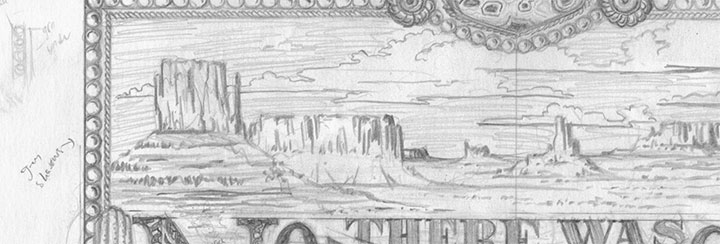
I’m not going to say much, so as not to spoil the surprise, but I thought I’d drop a few clues by way of my messy drawings—
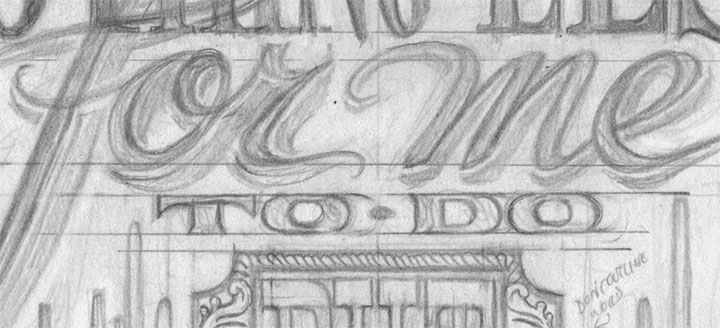
warts and all. As you can see by all the smudges and arrows, doin’ it by hand is hardly a perfect process,
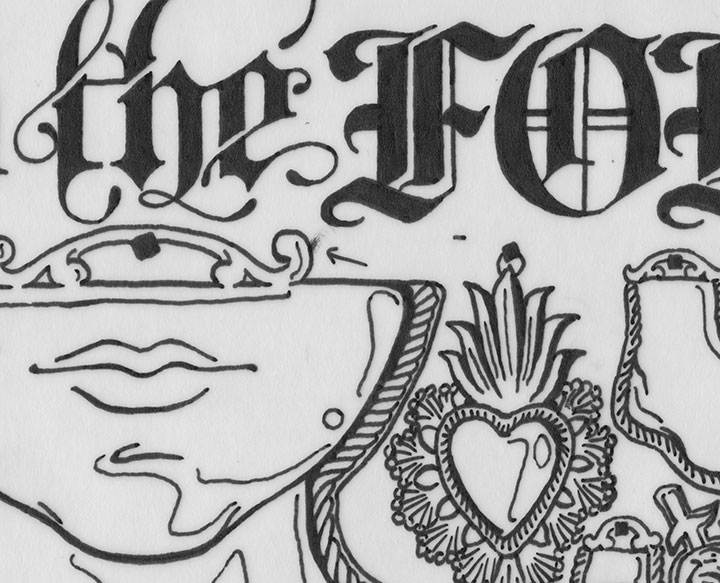
but I wouldn’t have it any other way.
On a Mission is on press as I speak, inching closer to the finish line every moment. Look for it here on Friday—see you then!
August 25th, 2010
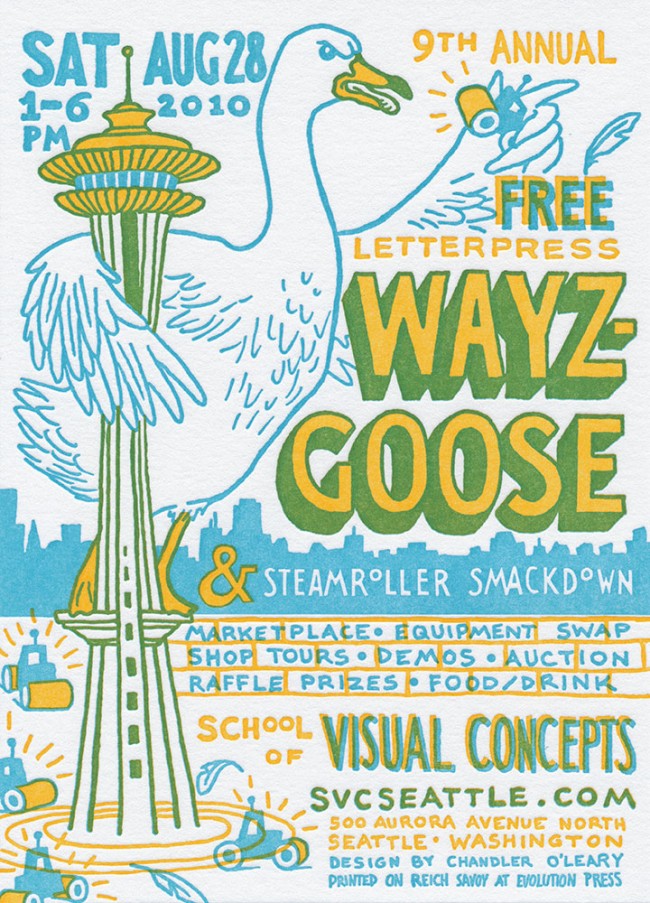
Jessica and I are waist-deep in the new Dead Feminist print (look for it here next week), so I’m just popping in to wave hello—and to warn you, in badly-dubbed English, about the giant goose climbing the Space Needle.
Just kidding … but they will be sending in the steamrollers. This Saturday, in the Needle’s mighty shadow, is Seattle’s biggest letterpress party of the year: Wayzgoose. The weather is supposed to be perfect, so come on over and say hi to scads of letterpress artists, print your very own keepsake in the studios, and referee the Steamroller Smackdown outside. Jessica and I won’t be steamrolling this time, but we will have a table in the marketplace—so don’t be a stranger!
Here’s the skinny:
9th Annual Seattle Wayzgoose
Saturday, August 28, 2010
1 to 6 pm
Free!
School of Visual Concepts
500 Aurora Avenue North, Seattle
More information and RSVP here
The lovely ‘Goose wranglers at SVC asked me to design this year’s postcard; I think I was watching too many Japanese monster movies at the time. But monsters and letterpress seem to go well together; the postcard is lovingly letterpress printed by the talented titans at Evolution Press
June 9th, 2010
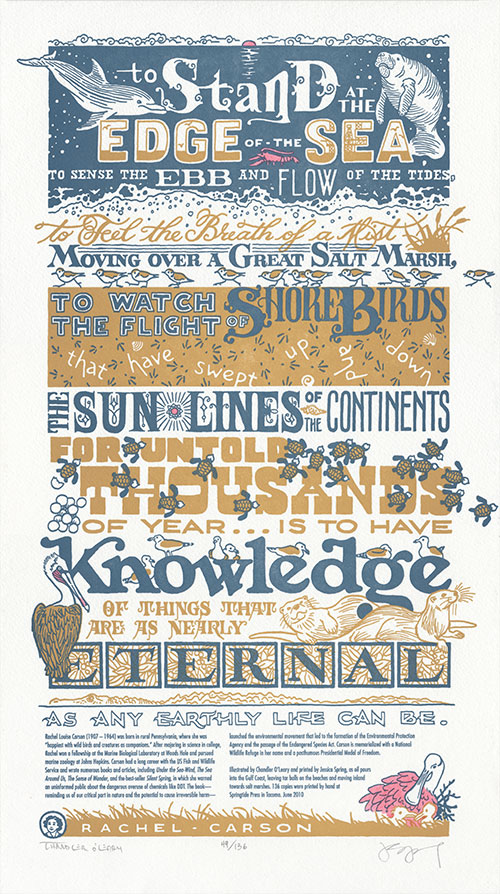
Okay, I know the title is a bit controversial. But it was either that or something laden with obscenities—Jessica and I are feeling murderous less than charitable towards the oil industry at the moment. Thus far the Deepwater Horizon/British Petroleum oil “spill” (leak? deluge? hemorrhage?) has poured tens of millions of gallons of oil into the Gulf of Mexico—a fact that stopped us in our tracks, mid-way through a different piece, and changed our course for this season’s broadside.
I wish I could say this was a fun piece to create; dwelling on current events and spending days poring through images of oil-soaked animals has been one of the most depressing, enraging experiences I’ve had in my career. Luckily, I could spend the rest of my energy drawing the inspiring quote by writer, scientist and environmentalist Rachel Carson:
“To stand at the edge of the sea, to sense the ebb and flow of the tides, to feel the breath of a mist moving over a great salt marsh, to watch the flight of shore birds that have swept up and down the sun lines of the continents for untold thousands of year* … is to have knowledge of things that are as nearly eternal as any earthly life can be.”
(*not a typo, I promise.)
This is by far the longest quote we’ve tackled yet, and I needed convincing before I could justify the pins and needles I’d feel in my hand afterward. But along the way, it occurred to me that the quote reads like a poem—with a rhythm that opened up all kinds of image possibilities.

I couldn’t face the idea of drawing any of the oil spill’s destruction, so I chose instead to focus on the wildlife affected by the spill—including several already-endangered species—and create an image absolutely teeming with life. A manatee and dolphin play in deep ocean blue, while plovers dash by in a sandy gold that becomes the sickly tea-colored oil pouring from a hidden offshore rig (okay, so maybe a little of my anger found its way into the drawing). Baby sea turtles inch their way to the shore; a roseate spoonbill nests in a corner; a brown pelican sits, surveying the scene. How many creatures can you find?
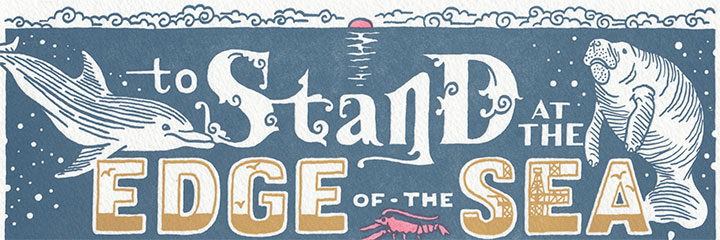
One positive note that we can hold onto is the hope that we might make a bit of difference with our art. Our Dead Feminists have made their way to 40 states and 9 countries outside the U.S., so the word is definitely spreading. And we’ll be donating a portion of the proceeds from Drill, Baby, Drill to Oceana, an international organization focused on ocean conservation and dedicated to ending offshore drilling.
There. I said it. We want to ban offshore drilling outright. Forever.
I don’t mean to offend any readers on the other side of that particular fence (if any are left; sometimes I wonder if our series hasn’t already alienated half of the population…), but this is one issue around which I simply cannot tiptoe.
But then again, Rachel Carson wouldn’t have, either.
• • • • • • • • • • • • • • • • • • • • • • • • • • • • • • • • • • • • • • • • • • • • • • • • • • • • • • • • • • • •
Drill, Baby, Drill: No. 8 in the Dead Feminists series
Edition size: 136
Poster size: 10 x 18 inches
Printed on an antique Vandercook Universal One press, on archival, 100% rag paper. Each piece is hand-colored and signed by both artists.
Colophon reads:
Rachel Louise Carson (1907 – 1964) was born in rural Pennsylvania, where she was “happiest with wild birds and creatures as companions.” After majoring in science in college, Rachel won a fellowship at the Marine Biological Laboratory at Woods Hole and pursued marine zoology at Johns Hopkins. Carson had a long career with the US Fish and Wildlife Service and wrote numerous books and articles, including Under the Sea-Wind, The Sea Around Us, The Sense of Wonder, and the best-seller Silent Spring, in which she warned an uninformed public about the dangerous overuse of chemicals like DDT. The book—reminding us of our critical part in nature and the potential to cause irreversible harm—launched the environmental movement that led to the formation of the Environmental Protection Agency and the passage of the Endangered Species Act. Carson is memorialized with a National Wildlife Refuge in her name and a posthumous Presidential Medal of Freedom.
Illustrated by Chandler O’Leary and printed by Jessica Spring, as oil pours into the Gulf Coast, leaving tar balls on the beaches and moving inland towards salt marshes. 136 copies were printed by hand at Springtide Press in Tacoma. June 2010
UPDATE: poster is sold out. Reproduction postcards available in the Dead Feminists shop!

June 3rd, 2010
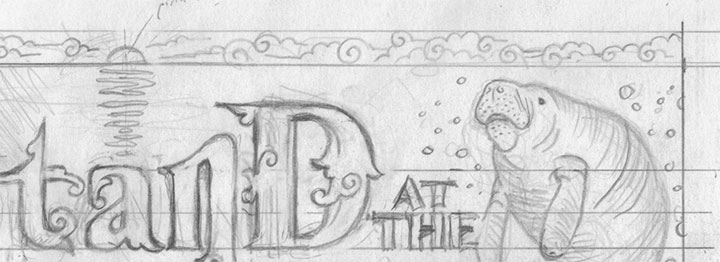
The next print in our Dead Feminists series will be making its in-person debut on Tuesday—these few snippets might give you a clue as to our latest theme. Jessica and I will be doing our dog-and-pony show at the Gig Harbor branch of the Pierce County Library; if you’ve missed our previous lectures, come check it out! If you have seen seen it, you’ll already know our schtick, but you’ll still get to see the new piece first! As always, you can also get up to speed by reading about our process here.
Pressing Matters: local letterpress artists combine craft with history
Tuesday, June 8, 2010
7:00 p.m., free!
Gig Harbor Branch, Pierce County Library
4424 Point Fosdick Drive NW, Gig Harbor, WA

We’re a month late with the new broadside for a couple of reasons. The longest (4 months!) and most annoying delay came from the fact that we’ve had to switch to a different paper. I know that sounds silly, but the paper industry is very volatile, and if you’ve ever used a type of paper that you love, only to have it be discontinued (or worse, the company goes out of business), you’ll know how frustrating it can be to find a reasonable facsimile. I guess we should have seen this one coming—the paper we’ve been using is not only extremely unusual (made from recycled clothing!), but it’s also made by a tiny, independent paper company. It’s a long story, but the short version is that the paper is now perpetually on back-order, and we had begun to notice quality issues. So! We’ve finally found a very good, high-quality replacement, and while it doesn’t quite have the Cool Factor of the other stuff, we certainly have a lot less to worry about.

The broadside will appear online (both here and in the shop) on Wednesday, so stay tuned for more information. And in the meantime, in case you’re debating whether it’s worth the Sturdy Gertie bridge toll to attend the talk, you can say hello to the giant octopus* on the way!
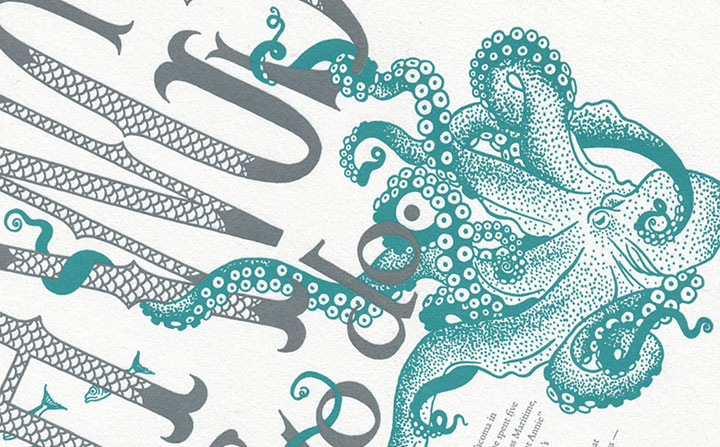
*I just learned that one of the world’s largest species of octopus lives in the Tacoma Narrows, right under the bridge—a fact that completely made my week, and that I’ve obviously been dying to work in to a blog post.
April 28th, 2010
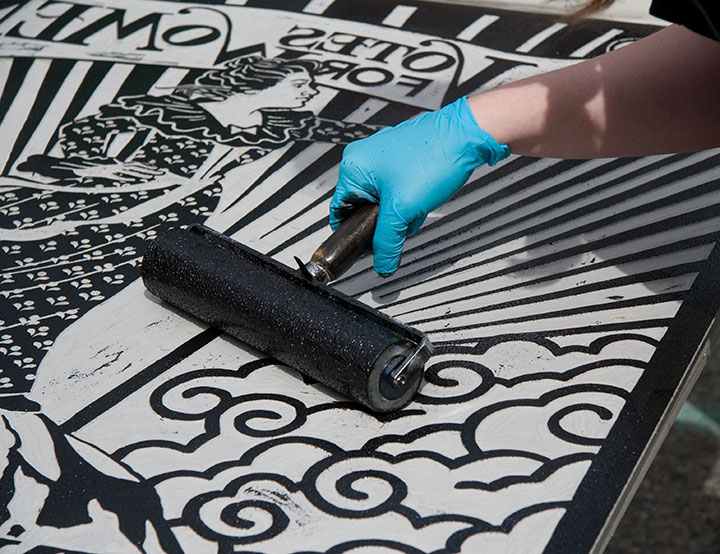
Inked up,
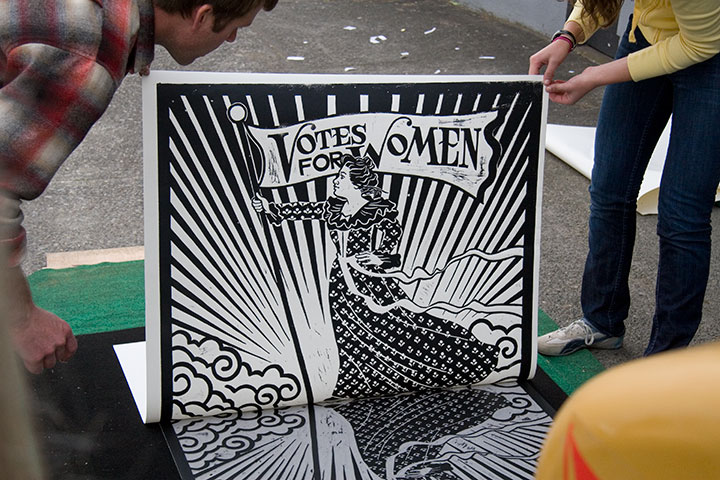
hand-pulled,
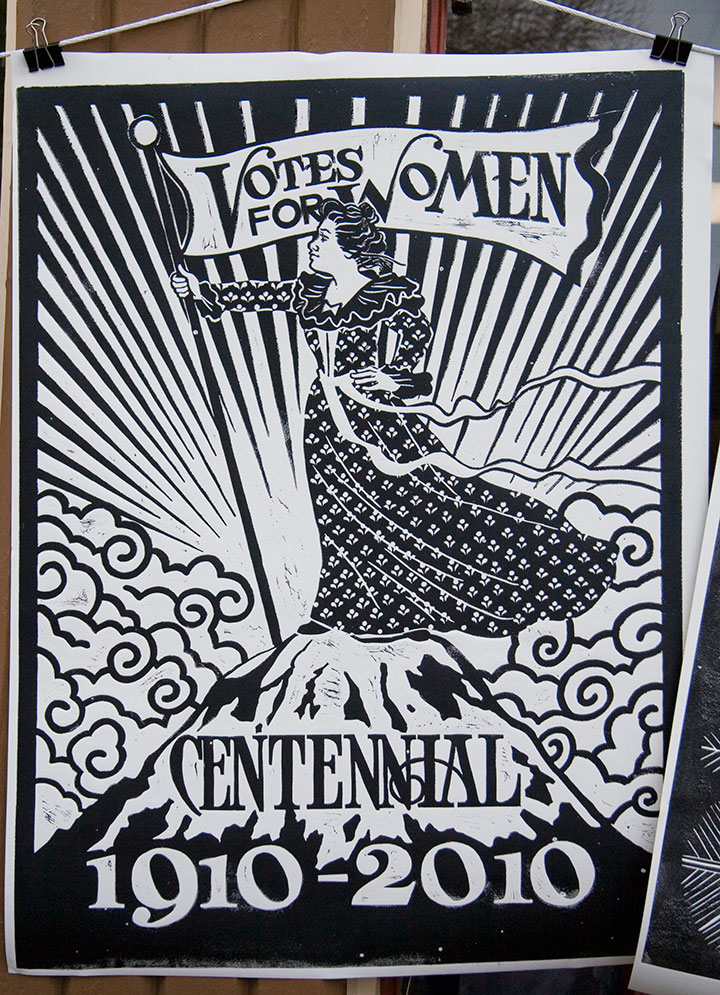
and voilà! Our second collaborative steamroller print, an unofficial Dead Feminist, inspired by Cora Smith Eaton King, who in 1909 climbed Mt. Rainier with a party of Seattle Mountaineers and placed a “Votes for Women” banner at the summit.

This year’s Wayzgoose was the biggest bash yet! We had all the regulars—
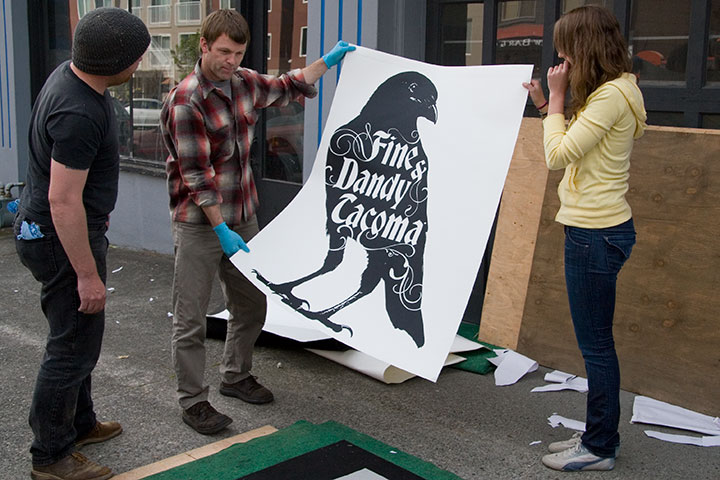
who churned out perfection under pressure (no pun intended)—
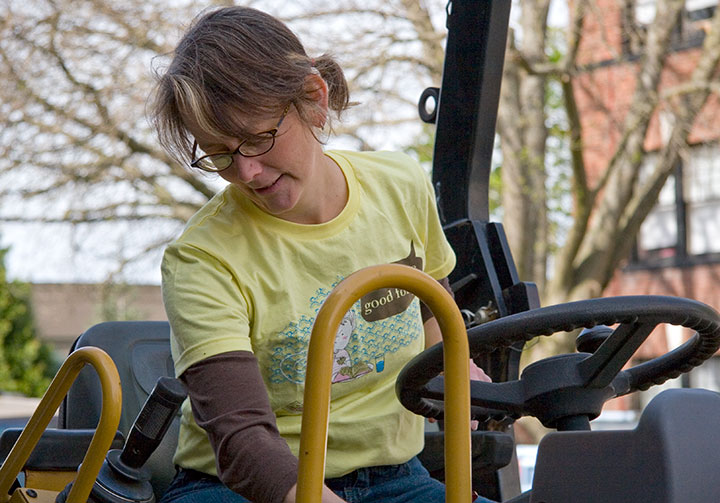
our beloved ringleader,

a certain befezzed flavor,

and a whole host of newcomers to round out the experience.
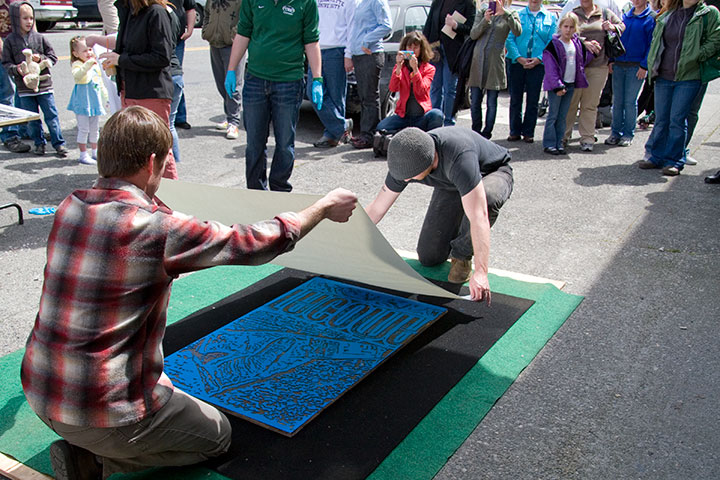
We had an enormous crowd (thank goodness for the good weather!),
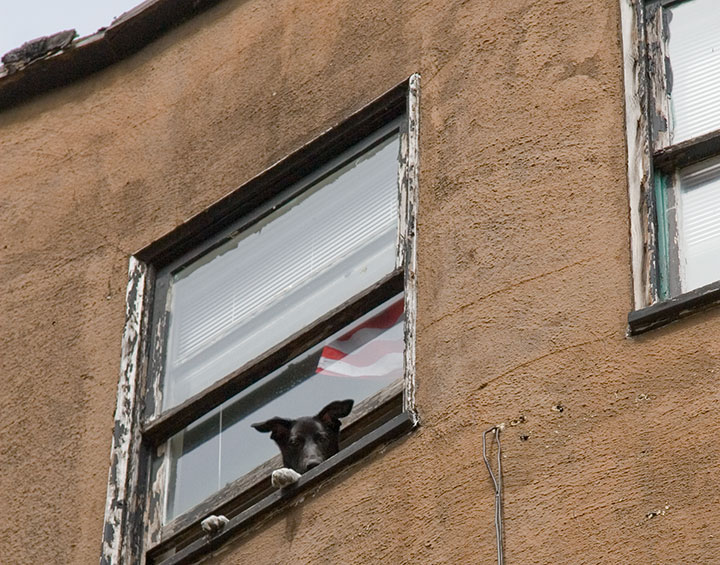
and even a few unexpected audience members.
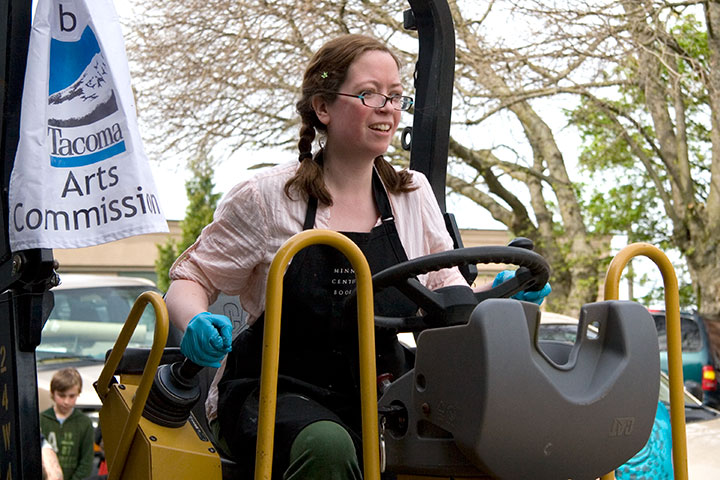
This year I got to try my hand at driving the steamroller,

but I think pretending was plenty enough for this little guy.
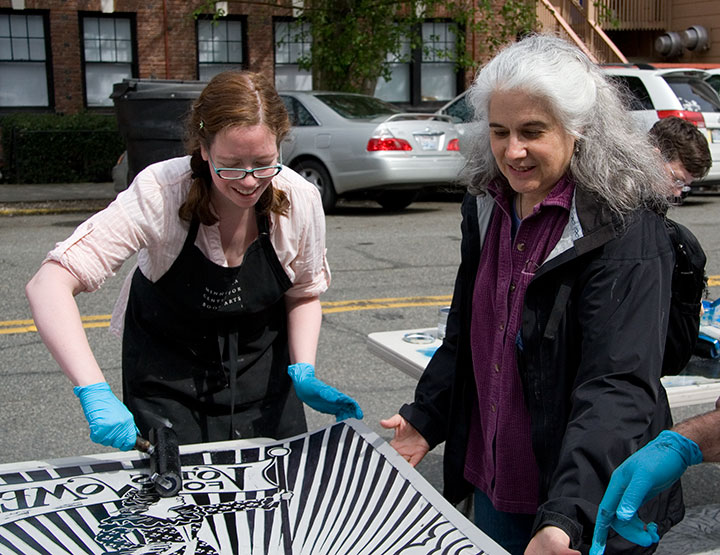
Thanks to everybody who stopped by to say hello, or stuck around to lend a helping hand.

And of course, a huge bucket of gratitude to the Tacoma Arts Commission for making it all happen!
One more acknowledgement: photography by Michael O’Leary. Thanks, Dad!
April 18th, 2010
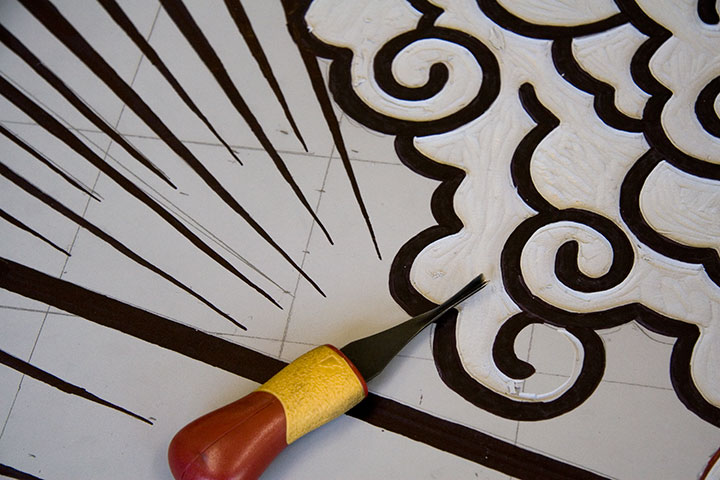
Jessica and I are carving like mad this week, getting ready for some quality steamroller time.
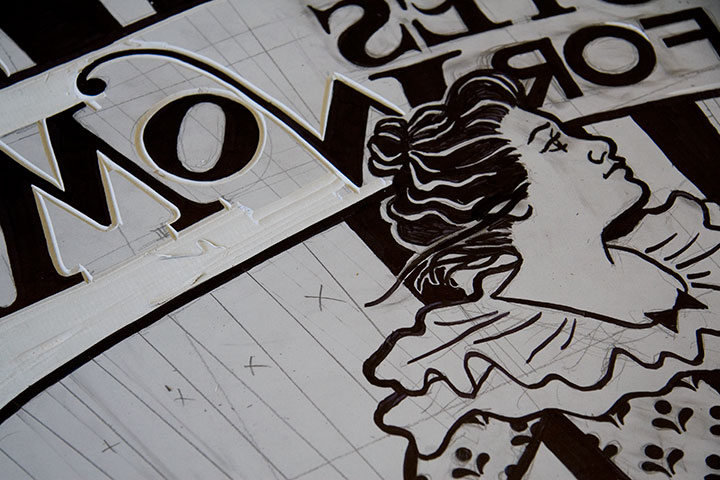
Next Sunday, April 25, is the sixth-annual Wayzgoose at King’s Books, right here in Tacoma. This year promises to be the biggest hullabaloo yet, with letterpress magnetic poetry, B.Y.O. t-shirt printing, papermaking demos, artist tables, and the star of the show: steamroller printing! Last year over 500 people came to check it out, despite a torrential downpour—and this year, the weather just might promise to behave, so we’re bracing for a mob. There’s a reason for the crowds: this is a heckuva lot of fun. Here’s the skinny:
6th Annual Wayzgoose!
Sunday, April 25, 2010
Noon to 4 pm
Free!
King’s Books
218 St. Helens Ave., Tacoma
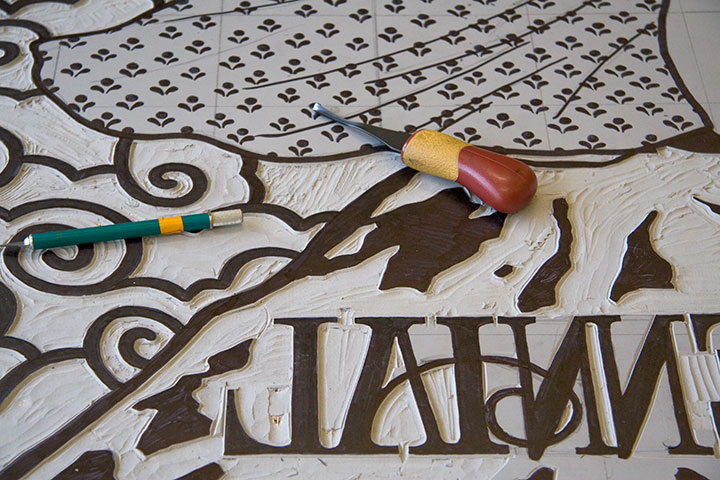
Eight artists and artist-teams will be printing gigantic three-by-four-foot linocuts in the street, including Jessica and me—we’ll be adding another unofficial Dead Feminist to our roster. (Take a gander at our last steamroller print here.) This is just a sneak peek; stop by next Sunday to see this block in action.
See you there!
February 20th, 2010
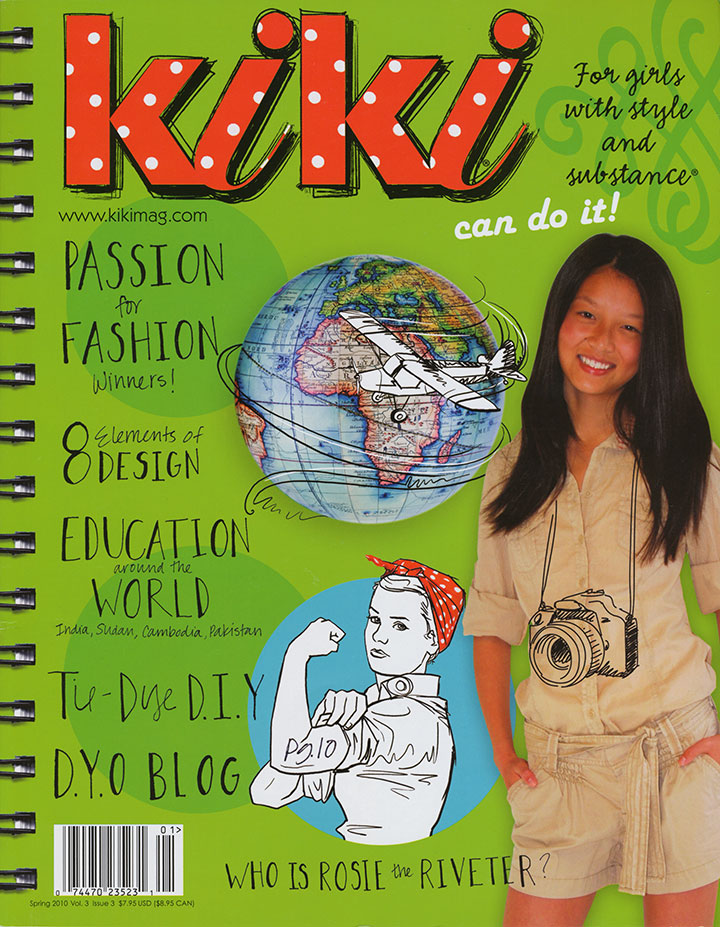
Jessica and I have had some seriously huge smiles for the past couple of days: we just received our copies of the latest issue of Kiki Magazine, which contains a feature on the Dead Feminists!
Before we were contacted for an interview, neither of us had heard of the magazine, but I can tell you that we became instant fans when we read its mission. Unlike so many other magazines written for teenage girls, which usually (even if inadvertently) tend to focus on questioning one’s body, popularity, attractiveness and overall self-worth, Kiki aims to empower girls with self-esteem, confidence, and a wide variety of knowledge and skills. As someone who is generally dismayed by the lack of respect with which our society tends to treat girls and women, and the self-loathing and doubts still being ingrained from their earliest experiences onward, Kiki seems like a breath of fresh air—and a huge relief.
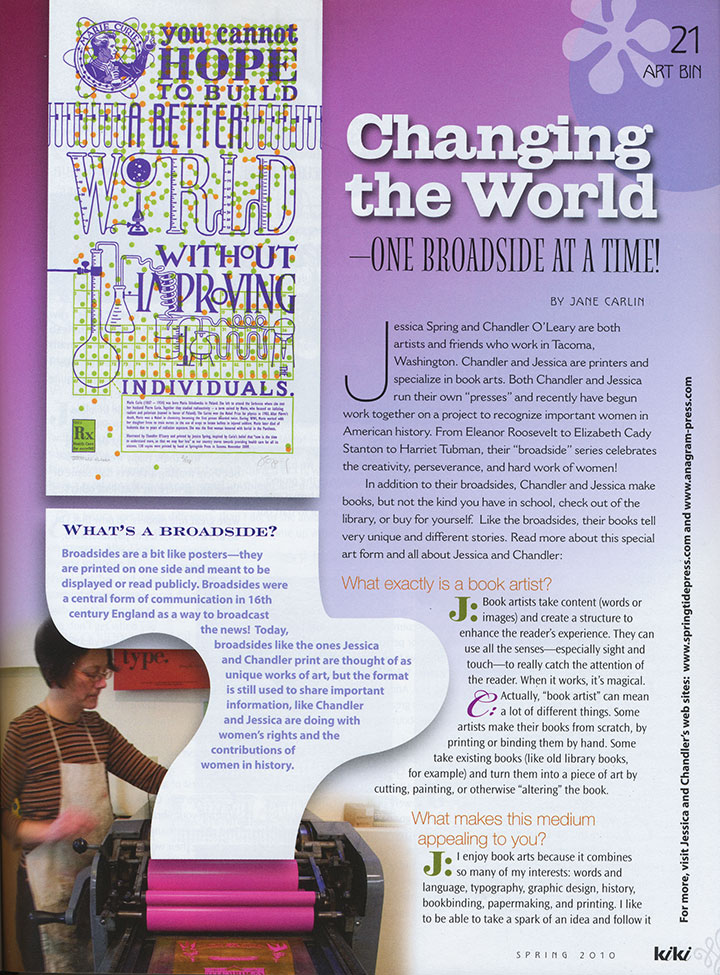
And hey—who are we really creating these broadsides for, anyway? What is it that we’re trying to change in our world? It’s not just about the social issues we cover with each piece—it’s about teaching the women and girls around us that they can be heard, that what they say and do matters.
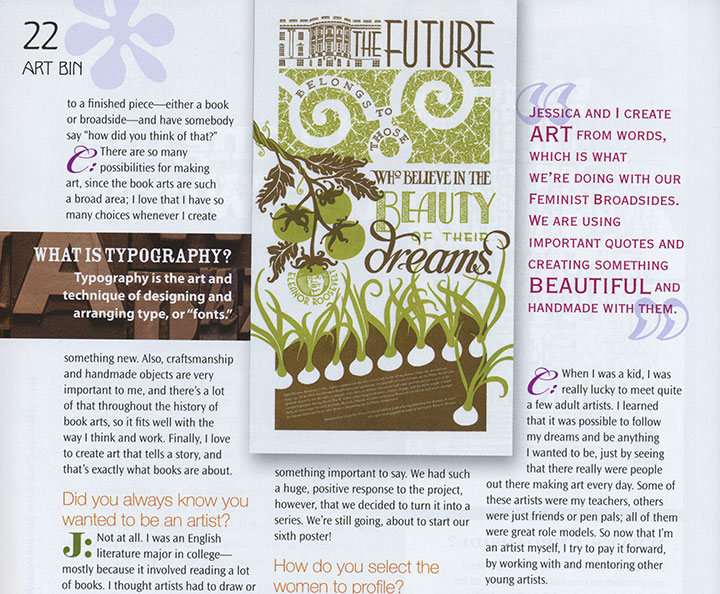
So Kiki gets an A-plus in my book, not just for the thoughtful content (no ads! No boy-crazy quizzes! All substance!), but for the fantastic design! This thing is seriously fun to read and gorgeous to look at. And look! My favorite part:
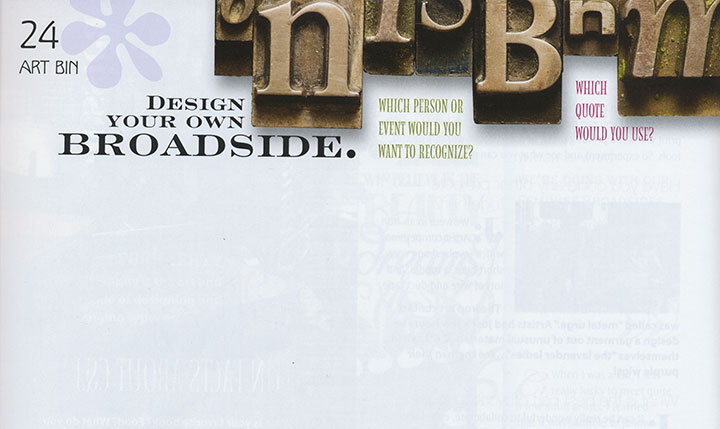
Rock on, Kiki. We’re honored to be a part of what you do.

![Chandler O'Leary [logo]](https://chandleroleary.com/wp-content/themes/chandleroleary/images/logo.png)































































